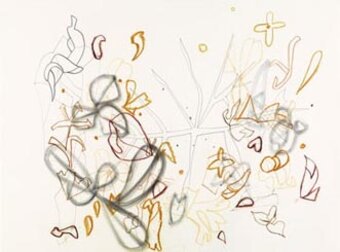Rainer Nepita
Vita
The alphabet of nature
Rainer Nepita, born in Schweinfurt in 1954, studied at the State Academy of Fine Arts in Karlsruhe and Freiburg from 1977-1983, including painting under Prof. Peter Dreher. In 1988, he received a scholarship for literature from the Baden-Württemberg Art Foundation.
Then, in 1985, he moved far away to South Asia. His collaboration with the company "Formation Carpets" began in Kathmandu/Nepal in 1996. He created art carpets for floors and walls. In 1996, he received his first art award, for contemporary art in the Ortenau region of Offenburg, followed by residencies at Studio Berlin in 2003 and 2006.
Nepita has lived and worked in Oberkirch/Baden since 1982.
His exhibition activity in Germany is impressive. The best overview can be found on his website (www.rainer-nepita.de), which is constantly updated.
A reference to the catalog "Rainer Nepita, botanica" is indispensable. It was published in 2009 by Galerie Anja Rumig, Ludwigstraße 73, 70176 Stuttgart.

In March and April 2008, works by Rainer Nepita were on display on the attic floor of the Heart Center. People have become accustomed to unusual picture titles, so that titles such as "BB8B" or "Alphabet" hardly arouse the curiosity of the vernissage guests. Obviously, these are series of paintings that now need to be viewed. The paintings are beautiful to look at. Differently colored bands divide strikingly colored backgrounds with an astonishing lightness. If you look at them for longer, the bands start to move, provided that the viewer's imagination is able to comprehend this. From here it is not far to consider whether the artist does not see himself as a choreographer who has his ribbons perform a previously rehearsed dance. It is a pleasure to watch and to change the stage repeatedly in order to be carried away by the one or other large-format painting.

Flora, watercolor, 31x22 cm, 2008
Badberg
But the titles of the images suddenly become interesting. Is this a kind of code that the choreographer uses to control the dance movements? The artist smiles and says: "You could understand it that way. Yes, the code conveys a message, not so much to the spectators as to the dancers, the ribbons or bows, or whatever. Then the artist opens the curtain: stage free for a fascinating artistic scenario!
BB" refers to the Badberg pictures or the "Badberg cycle", which Nepita presented the year before, in 2007, in the customer hall of the Kreissparkasse Weingarten. The Badberg with its round, flattened and partially treeless summit can be found in the Kaiserstuhl. The path leads from Bötzingen and Oberschaffhausen to Oberbergen. Shortly before the well-known wine village, the mountain rises up on the right. A walk up to the summit may reveal the code "BB8B". It's the grasses swaying slightly in the wind that play wantonly around your feet, the anemones swaying drunkenly back and forth or many a butterfly striving for a rewarding goal in the dancing ups and downs. And much more.

Two works from the Badberg cycle 21 in the recreation room of ward 4 Graphite, oil, acrylic/canvas, 160x120 cm, 2005
On the artist's website www.rainer-nepita.de/8.html, readers can gain interesting insights into his working methods. One of his areas of inspiration and work is the Badberg. This is where he finds the basic forms of his shapes, motifs and compositions - the fauna and flora of the Badberg. Nepita makes drawings of grasses and flowers, as well as their butterfly and caterpillar guests. He collects the leaves in workbooks, which serve as the basis for his figurations, the dancing play of ribbons and his half-hidden shadows.
Eurasia and St. Lambrecht
The figurative scenario gradually becomes clearer, unfolding its compositional power as an abstract pattern of movement. The Eurasia drawings from 2008 and the St. Lambrecht cycle created in the same year are noteworthy and definitely worth seeing as an aid to understanding the large-format paintings. They are to be understood as an artistic link to the Badberg cycle and the "Alphabet". In them, formations can be identified that appear as leaves, grasses and perhaps even butterflies. They subordinate themselves to the canvas design begun by the artist without giving up their rhythm of movement. Quite the opposite: they are concretized in a new scenario, the Nepita stage, which now appears spatial after the formations painted in grisaille tones have been identified as webs of shadows on the background backdrop.

St L V, Graphite and earth colors on paper, 56x76 cm, 2008

Eurasia+IV, pigments 56x76 cm, 2008
Alphabet
Nepita creates an artistic secondary cosmos. The self-evident, which we tend to overlook in search of the distant, becomes something special by taking on an endearing form. Once you have familiarized yourself with the structure and composition of the picture, it is not difficult to relate to the natural world. On the contrary, one becomes curious and wants to transfer the now familiar pictorial pattern to observe the flight of the butterflies, the swaying of the blades of grass or the nodding and tilting of the petals. In other words, viewers have learned Nepita's pictorial grammar without realizing it. But before the grammar comes the letter, whose system is called the alphabet.
In recent years, Nepita has created a number of large-format pictures entitled "Alphabet". If you compare them with examples from the Badberg cycle, for example from 2005 or 2006, it is noticeable that the band formations are more prominent, becoming denser, more entangled and drifting apart. In the following painting, the inner world of the tangle is explored. Here it floats and billows. Ribbon molecules, it seems, dance around each other to organize or provoke the next entanglement. They are probably part of the smallest alphabet unit, in order to produce veritable letters such as leaves, blossoms or buds. The artist is the author who lets nature show him how to spell and write with color forms. He is even more, a choreographer who calls his artists onto the stage, assigns them their positions, sets the beat and stages the wonderful ballet.
Rainer Nepita's paintings can be seen in galleries. Where else? Unfortunately, he is still denied a theater stage. Perhaps an artistic director will recognize and appreciate the dancing, sonorous play of his paintings as a source for theatrical or musical productions - as a kind of "backdrop partner" for the performers and the interior. But there is an alternative, an obvious way to hear the whispering and whispering of the Nepita alphabet. These are the carpets.

Alphabet, oil and graphite on canvas, 50x60 cm, 2010

Alphabet, oil and graphite on canvas, 50x40 cm, 2009

Carpet T4, 1996

New Castle Museum Rudolf Wachter, Kisslegg, 2006
Carpet
In 2006, Nepita exhibited his floor and wall tapestries at the Rudolf Wachter Museum in Kisslegg - including the results of his collaboration with the company "Formation Carpets" in Kathmandu/Nepal. Now he was able to enter his stage in the truest sense of the word. The rooms, flooded with light, resembled an artistically refined natural theater. The floor rose up to the wall, which leaned towards the floor. The dimensions were suspended. The carpet motif not only suggested spatiality through color perspective shading, but also staged it and demonstrated true space. The Nepita cosmos was captivating. And you were happy to let it happen to you.
The reality of nature - what is that? The outer dress, multifaceted and always in motion? It takes an alphabet to write nature, to be certain of it, to understand the eternal becoming of natural things. Nepita has found an artistic formula that shows us a new way into nature. Filled with images from his cycles, a walk over the top of the Badberg or elsewhere becomes an experience. Perhaps a conversation could begin with these silent but lively companions.

